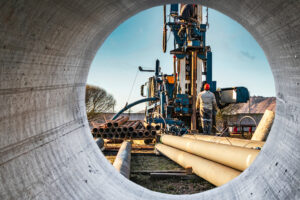Exploring and drilling for natural gas, oil and other resources has become a booming profession around the world. Drilling, like most technical professions, has its own unique language and set of definitions for parts and job tasks.
Stabbing, in the driller’s world, has an entirely different definition than the one that immediately comes to mind. Rather than the act of using a knife, it refers to placing the male threaded end of a section of pipe into the female threads of another section of pipe before making a tight connection. The joined sections of pipe are usually part of a pipe string put together on the deck of a rig while drilling at a site.
Another alien term to people who outside the drilling industry is stabbing guide. A stabbing guide, or funnel guide, is made of high-grade steel or a strong urethane and is used during the make up of a string of pipe to align the pin to box threads between two sections of pipe and to prevent damage to the threading or prevent a connection failure.
Stabbing guides models are designed to fit a broad range of pipe size, from 1″ to 18″ and for use in tubing, casing and drilling applications. The guides are opened and closed using a spring loaded latch in the closed position or a torsion spring.
In demanding and exacting work like drilling, stabbing guides provide an extra measure of precision to ensure that pipe connections are properly aligned, secure and tight. At MSI, we have a selection of stabbing guides that can be used for both standard and heavy duty. Contact us for more information or to request a sample.




